182 Search Results for rett
January 4, 2013
by Robin Parker -
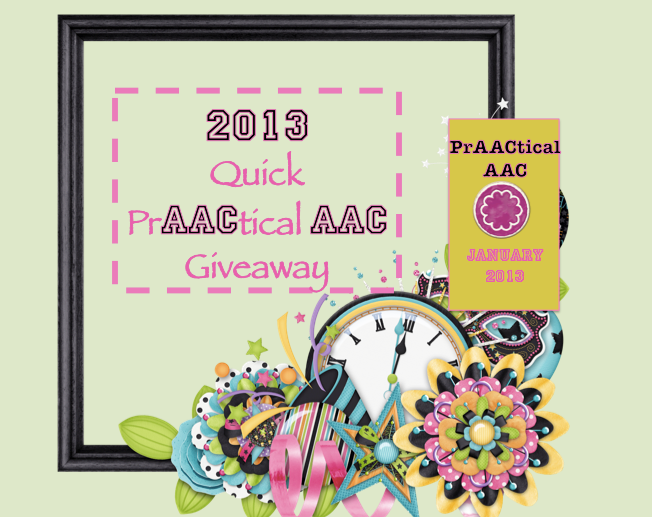
We are so excited for a great 2013 and we have 2 AAC Giveaway Winners! Congratulations! Thank you to everyone who participated and to Therapy Box Apps Scene & Heard- (Scene & Heard) & Enabling Devices/Toys for Special Children #1 Enabling Devices/Toys for Special Children has generously donated a 4-Compartment Scanning Communicator. Please show your appreciation of Enabling Devices by visiting and liking their Facebook page. #2 Scene & Heard- We have one code for the Scene & Heard AAC app that supports multiple languages through voice recordings and supports switch scanning. Scene & Heard takes a visual scene approach to AAC and we are so appreciative to T-Box Apps for donating their app for this giveaway. Don’t forget to show your appreciation by liking their Facebook Page. Enter the Giveaway- How Does It Work? We use Rafflecopter to administer the giveaways. All entries made through there will be counted toward our drawings. Enter now and everyday until... [Read More...]
January 2, 2013
by Carole Zangari -
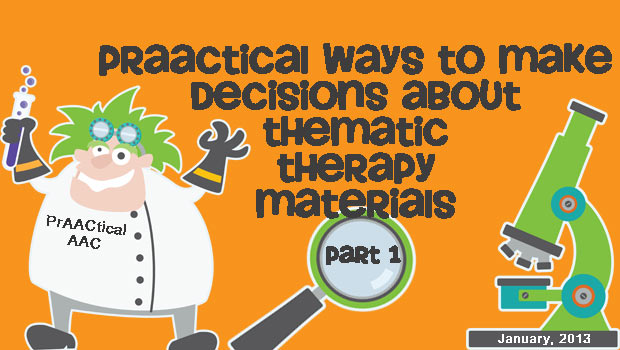
Is it just us, or have other people been blown away by the number of SLPs sharing therapy materials that they’ve designed? It seems like every time we visit sites like Facebook, Pinterest, and TeachersPayTeachers, there are more SLPs posting things that they’ve made. Most of them are incredibly adorable, reasonably priced, and even free. Many are based around a particular theme, such as a holiday or season, or a conceptual theme, such as pirates, the circus, or outer space. We love the cute graphics and fun fonts, and bet that many of you do, too. Cuteness and the ‘fun factor’ are compelling, but which ones are a good fit for your AAC therapy? In this post, we want to open a conversation with prAACtical thoughts about making solid clinical decisions when choosing therapy materials. I’ll be sharing some things that can be helpful when working with kids who have... [Read More...]
December 26, 2012
by Carole Zangari -

Sometimes the pages of communication books can be hard to turn, particularly if the pages are stiff or laminated. Here are some tried-and-true methods of putting spacers between the pages to make the books easier for unruly hands to handle. Use a small square of soft Velcro to a corner of the page. The adhesive-backed Velcro makes this a quick and easy fix, and it’s a good way to use up leftover scraps. Foam stickers from a craft or dollar store work well if you only need a small amount of separation between the pages. We love that you can get them in a wide variety of shapes and themes (e.g., dinosaurs, soccer balls, princess crowns). Great way to personalize the book based on your client’s interests. Colorful pom-pom’s can be hot-glued to one end of a paper clip. Use the other end to clip the fluffer to the page.... [Read More...]
December 22, 2012
by Robin Parker -
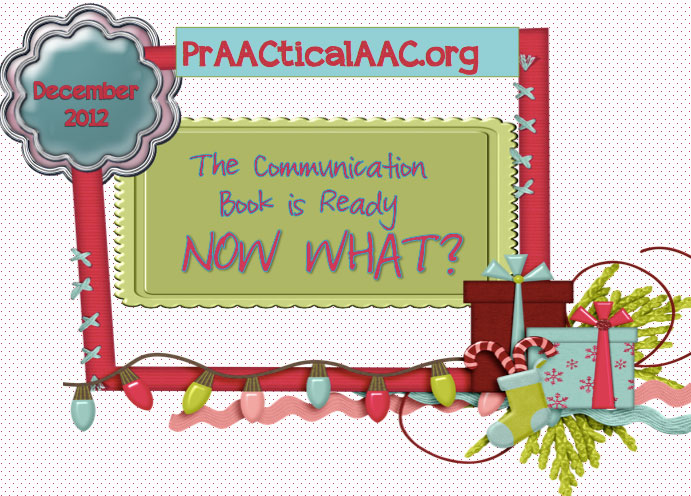
The Communication Book is Ready… Now What? The fun begins…. Yes, we really do think that TEACHING a learner to USE the communication book is FUN. We get to participate in lots of meaningful language experiences, we get to be creative, we get to watch language blossom, and we get to be surprised by the communication competence ALL of our learners show us after prAACtice, prAACtice, and for some more prAACtice . The best way to get started with communication book teaching is to begin by trying out different teaching tips, strategies, and resources and find out what works best. Each communication dyad (communicator & communication partner) is different so the combination of strategies that will work will vary but at the core of the teaching process, there should be fun, motivation, and of course progress. STRATEGIES and CONSIDERATIONS Aided Language Input (ALI)– We can not say enough about... [Read More...]
December 15, 2012
by Carole Zangari -
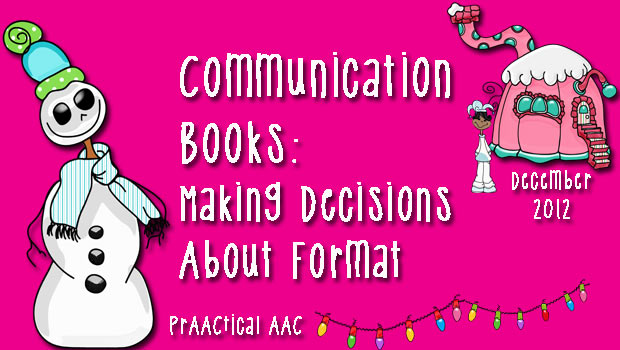
Four-year-old Josiah had a tiny one that was clipped to his belt loop so it was handy all throughout his day in preschool. Mr. Allan, who was hemiplegic and used a manual wheelchair, liked to keep one underneath his right thigh so he could grab it quickly whenever he wanted to talk. Dougie’s was big, really big, and he carried it under his arm wherever he went. Marla’s was a permanent fixture on her wheelchair laptray, and if she came without it because a caregiver forgot to put it on, it was likely to be a very l-o-n-g day. Geena’s looked like a DayPlanner and had it’s own special compartment in her purse. What are we talking about? Communication books, of course. And despite the fact that they all served the same general purpose, the communication books referenced in these examples couldn’t have looked more distinct. In this week’s post,... [Read More...]
December 11, 2012
by Carole Zangari -
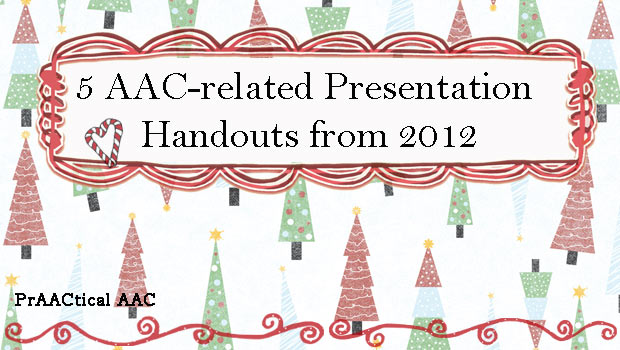
One of our deepest holiday wishes is that every AAC-loving clinician could have an increased travel budget for professional development. Until then, here are some handouts from AAC presentations at conferences around the US. From the ISAAC Biennial Conference in Pittsburgh: Effects of Early AAC Intervention for Children with Down Syndrome by Janice Light and Kathryn Drager This was a well-attended session by Jane Korsten & Terry Foss at ISAAC 2012: Assessment Strategies for Individuals with Sensorimotor Differences Wish I could have been at Deanna Wagner’s session at ARSHA on AAC for Students with Visual and Multiple Disabilities: How to Plan and Implement a Successful AAC Treatment of Childhood Apraxia of Speech: A Checklist for Evidence-based Practice by Sue Caspari at the 2012 ASHA Schools Conference Theresa Bartolotta & Patricia Remshifski’s ASHA session on Communication & Swallowing in Rett Syndrome: An Update for Clinicians
December 5, 2012
by Robin Parker -
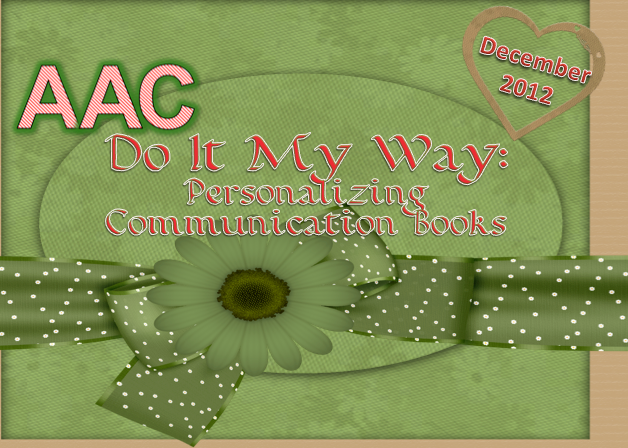
The topic of communication books was introduced this month. We will continue to think about the multitude of decisions to make as we design individual communication books. Obviously, content is the most important issue, but we are often reminded that function and form must go together. Carole gave some great examples of reasons to make the books appealing and personal. I had a situation this week that illustrated this concept perfectly. We continue to learn from the ‘learners’ that we are teaching. I know a little girl with autism who most people think does not care about her peers or how things look. She uses some natural speech and a no-tech communication book. She uses the communication book during her speech-language therapy sessions but only inconsistently outside of the therapy room. She has not expressed interest in taking the communication book with her and although she has some specific visual... [Read More...]
December 1, 2012
by Carole Zangari -
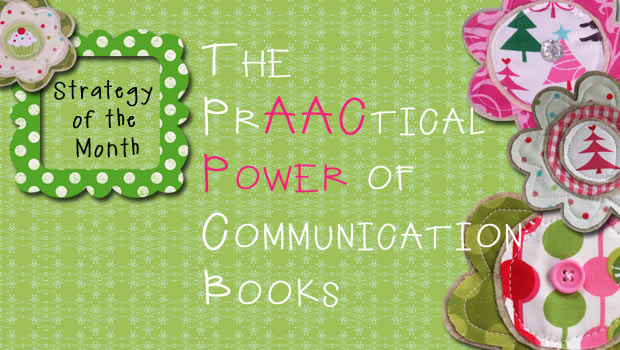
There’s something about the month of December that makes us a bit nostalgic. As we prepare for the holidays, our thoughts drift to the past. Simpler times. Tradition. The way things used to be. And, so, for our Strategy of the Month, we step away from the latest app or fanciest SGD and turn our attention to one of the tried-and-true tools from the past: Communication books. They used to be ubiquitous but now they’re becoming almost a rarity. We’ve decided to focus on them for a couple of reasons, but the main one is to spread the word that it doesn’t take a sizeable budget to give someone access to real language. If you have access to a computer and printer, you can make a really robust communication book for little or no money. It seems so simple: Put some words and pictures in a book. Show someone how... [Read More...]
November 23, 2012
by Carole Zangari -
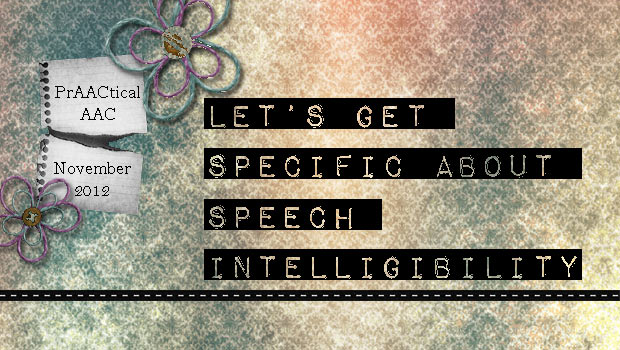
When we’re writing AAC evaluation reports, compiling funding documents, and summarizing the present level of performance in IEPs, we frequently comment on speech intelligibility. In some cases, we’ve administered a standardized assessment instrument and are sharing those results. Often, though, the comments are more descriptive in nature. It is not uncommon to read documentation in which someone with articulation difficulties is described as having speech intelligibility that is mildly, moderately, or severely impaired. Those categories are pretty broad, open to interpretation, and can be quite vague. What do we really mean when saying that someone does or doesn’t have intelligible speech? To narrow down the meaning, we specify the two variables that have the greatest influence on how comprehensible the communicator’s speech output actually is: the context and the communication partner. Specifying whether the context is known and the partner is a familiar one, helps us better interpret the descriptors... [Read More...]
October 24, 2012
by Carole Zangari -
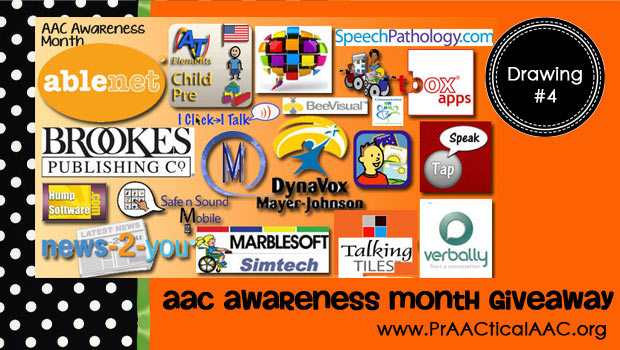
It’s been an exciting AAC Awareness Month! There were 25 lucky winners in the first two drawings and earlier today we drew the names for the third round. The winners for Drawing # 3 are Tanya Keller Scott (#473), Rachel Berry (#266), Carrie Walls (#9), Felicia Moore (#566), Diane Saunders (#34), Jillian Mayo (#164), Juliana Escobar (#425), Amy Vinson Taylor (#138), Allyssa Lucas (#323), Katrina Stebbins (#88), Kristina Frenzel (#480), Jennifer Schroeder (#510), Christine Cobb (#587), Lauren Enders (#53), Mark Neely (#291), Cassie Cann (#213), Amy M (#182), Cassandra Stafford (#366), Monica Venezia (#547), Lizzie Feldman (#579), Melissa Nicole (#364), Erin Finnegan (#434), and Kia Hughes (#383). Congratulations to the winners! Our 4th and final drawing promises to be the best one yet. Please join us in giving virtual round of applause to these generous companies: Ablenet, Inc Abilipad Alexicom Avaz BeeVisual Dynavox/Mayer Johnson Gail Van Tatenhove, PA Hump Software iClick iTalk MarbleSoft Mozzaz News-2-You Patient Provider Communication Paul H. Brookes Publishing Company RJ Cooper Safe N Sound Mobile Say It with Symbols... [Read More...]









